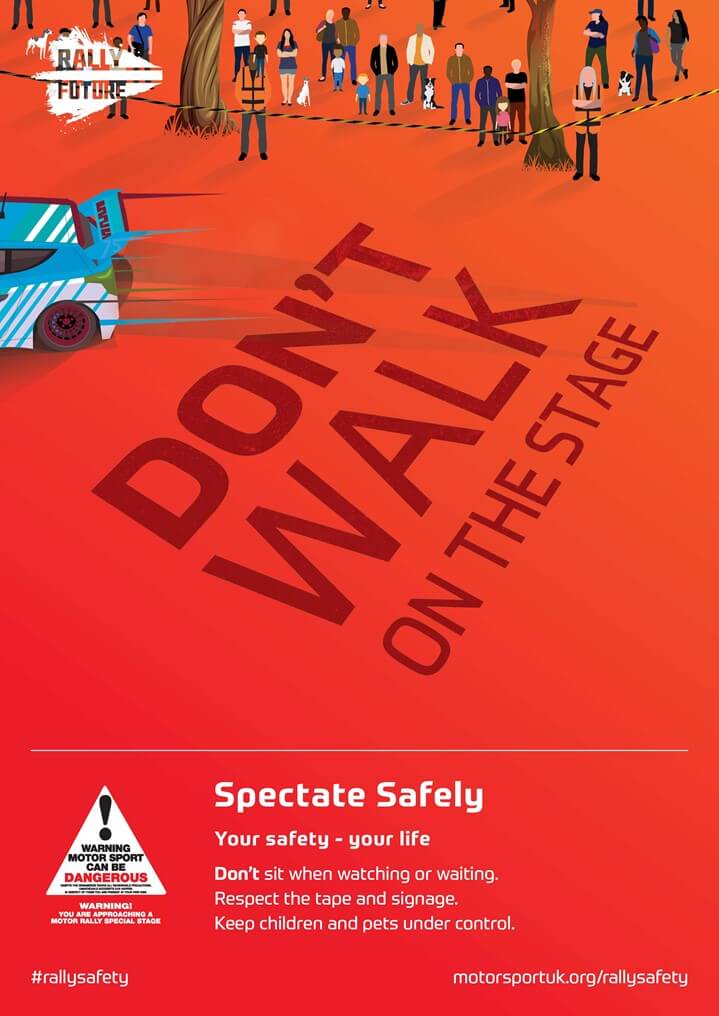
What is a Stage Rally?
A special stage (SS) is a section of closed road at a stage rallying event. Competitors attempt to complete the stage in the shortest time. A rally on a special stage is coordinated such that each competing car begins after a set interval, to reduce the chance of impedance by other competitors. Each special stage is a relatively short section, usually up to about 10 miles in length. A rally usually comprises approximately 10–15 special stages. The driver with the lowest overall time for all special stages in an event is the winner.
The roads on which special stages are held vary from rally to rally, from the asphalt mountain passes used on the Monte Carlo Rally to the rough forest tracks used on the Rally GB. Surfaces such as ice and snow or desert sand are also common, with the aim of providing a challenge for the driver and crew as well as a test of the car’s performance and reliability.
While competing on a special stage, the drivers and co-drivers can have no support from their teams (except through radio/phone contact) and must deal with any breakdowns or problems themselves.
Typically, each car will be given a specific start time for a stage at 1 minute or 30 second intervals. In the minutes before setting off, a car will wait stationary at the start point until his scheduled start time. He may begin immediately at that time, and usually an official (using hand signals) and the co-driver (through speech) will provide a ten-second countdown. The timing of a stage for a particular car starts at its scheduled time, not when it passes the start point. At the end of the stage, there are two sets of markers. The first is usually referred to as the flying finish, and is the point at which timing for the stage ends. The name comes from the fact that a car will be traveling at full racing speeds when it passes this post. Several hundred meters further along the stage is the stop control point, where the car must come to a halt in order for officials to record their time and check paperwork. Approximately 50 meters after the stop point is the end of the special stage restrictions.
The cars must travel between special stages on public roads, often known as transport stages. While on public roads, all local traffic laws must be obeyed, so all cars must be roadworthy and taxed and insured. Drivers may be given a scheduled time to arrive at their destination to ensure they do not speed during the journey, with penalties for arriving too soon or too late (although the margin for late arrival is quite large).
It is common to see rallies containing a “Super Special Stage” (SSS) or “Spectator Stage.” These are timed stages, like standard special stages, but are held on short purpose-built tracks, often in outdoor stadia, but occasionally in covered venues. Commonly two cars will set off at the same time and at the halfway point of the stage will swap lanes. The short distance means that the difference in times between the top runners is often negligible, and so the stage is of little relevance to the overall classification.
Rally Terminology
An area set aside for each competitor to service and repair their car during the course of the event. Things you would usually see are the changing of tyres, altering of suspension setups and in some cases some minor body repairs in the event of an accident. However, it’s not unheard of for a team to replace major components during the time allowed for service such as gear boxes and hub assemblies. Service is also where the rest of the team will be during the rally and the day before to make sure everything runs smoothly for the driver and co-driver.
Time Cards must be presented at each Control for rally officials to record the actual time on it
Time penalties
If crews are late at a Time Control they are given a time penalty. For early arrival – 1 minute per minute or fraction of a minute early. For late arrival at a Main Control (out) – 10 seconds per minute or fraction of a minute late. Incurring time penalties can have a significant bearing on the rally’s final results.
These are the sections of the rally route that link the special stages together. These are often public roads where all traffic laws must be obeyed. Accordingly all cars must be roadworthy (with MOT certificate if required) and be taxed and insured. The time schedule between Special Stages is set to ensure that all road sections have a maximum average speed.
Located a safe distance after the flying finish, where all crews must stop to have their time recorded on their Time Card.
Sometimes referred to as the opening or course car. It covers each stage in advance of the competing cars. The zero car(s) acts as a wake-up call to spectators and marshals forewarning them that the main action will shortly be following (usually around 10 minutes). The zero car goes through the stage at ‘close to rally speed’, to give spectators and marshals a taste of what’s to come. Whilst doing this the crew must check that just about everything in the stage is in its right place. That means ensuring that stage furniture (arrows, barriers, etc.) and rally officials (marshals, radio cars, etc.) are all in their correct positions and there are no spectators stood in dangerous locations. On larger rallies you may find up to three ‘zero’ cars numbered 000, 00 and 0.
Based at the Rally HQ this is where the drivers and co-drivers sign-on for the rally, and have their documentation including insurance and licences checked.
The driver momentarily turns the wheel in the opposite direction before turning the car into the correct direction for a corner. This action creates a shift in the car’s weight causing it to flick into the corner.
Is a term used to describe cars built to the specification set by the Fédération Internationale de l’Automobile (FIA), the international motorsports governing body, and used to compete in the outright class of the World Rally Championship (WRC). The WRC specifications were first introduced by the FIA in 1997. World Rally Cars must be based on a production car that has a minimum production run of 2500 units and are hand built at a cost of around £500,000.
Sometimes called the Navigator. This is the person who sits next to the driver and is responsible for providing the driver with accurate route information and making sure they keep to their time schedule. The co-driver should also provide the driver with information to enable the special stages to be driven as quickly as possible.
This is a Maximum time allowed to complete the stage also know as a fixed limit of accrued lateness. This normally happens if a car breaks down, has a puncture or crashes during the stage, after which the crew are no longer allowed to continue to compete. This enables marshals and other personnel involved in running a rally to only wait for a fixed amount of time after the last car was due before closing the control.
Is the point at which timing for the special stage ends. The name comes from the fact that a car will be travelling at full racing speeds when it passes this post. Approximately 50 meters after the stop point is the end of the special stage restrictions.
As the name suggests a ‘Closed Park’ which is a restricted area where no service can take place.
Supplied by the organisers, the Road Book contains maps, tulip diagrams and timings for all the special stages and road sections of the rally.
The technique used by the driver to control a sliding car whereby the driver steers against the cars drift (opposite lock) to reduce the risk of the car spinning out of control.
Whilst still using the right foot to operate the throttle the driver uses their left foot to operate the brake pedal. This action de-stabilises the car allowing the driver to put it into a controlled (we hope!) slide, a technique that is often adopted on the approach to a corner.
In international rallying, R5 refers to a class of cars competing under Group R regulations. R5 regulations were introduced by the FIA in 2012 as a replacement for the Super 2000 class. R5/Rally2 cars are based on production cars and feature a 1600cc turbocharged petrol engine. R5 cars are a step down from World Rally Cars in their power and performance. They are eligible to compete in the World Rally Championship and in a dedicated series known as the World Rally Championship-2. This championship is exclusively open to manufacturer and professional independent teams competing in R5 cars. In 2020 and 2021, privateer entries in R5 cars contested the World Rally Championship-3. R5 cars also compete in regional championships such as the European Rally Championship and national-level events such as the British Rally Championship.
Cars to look out for
See if you can spot these cars on stage
Fiesta R5
SAFETY TIPS
Rallying is potentially very dangerous and we appeal to everyone to stay alert and follow the marshals instructions. If they ask you to move please do so as it’s for your own safety. Please remember if the organisers deem a stage to be unsafe they will cancel it – don’t be the one who causes it to be cancelled!
Watching a live motor sport event is a thrilling experience and one of the best ways for fans to get close to the action, experiencing the sport’s sights, sounds and smells first-hand.
Motorsport UK, event organisers and venues strive to keep spectators safe but ultimately all spectators are responsible for their own personal safety.
Here are some tips that spectators should remember at live events:
On rallies in particular, remember:

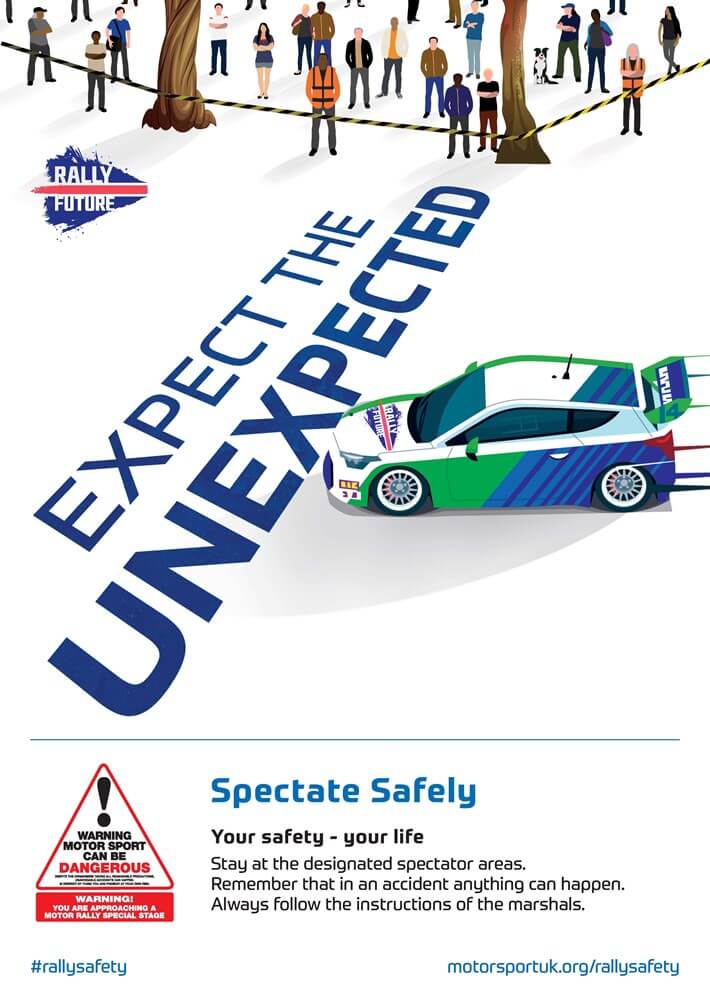
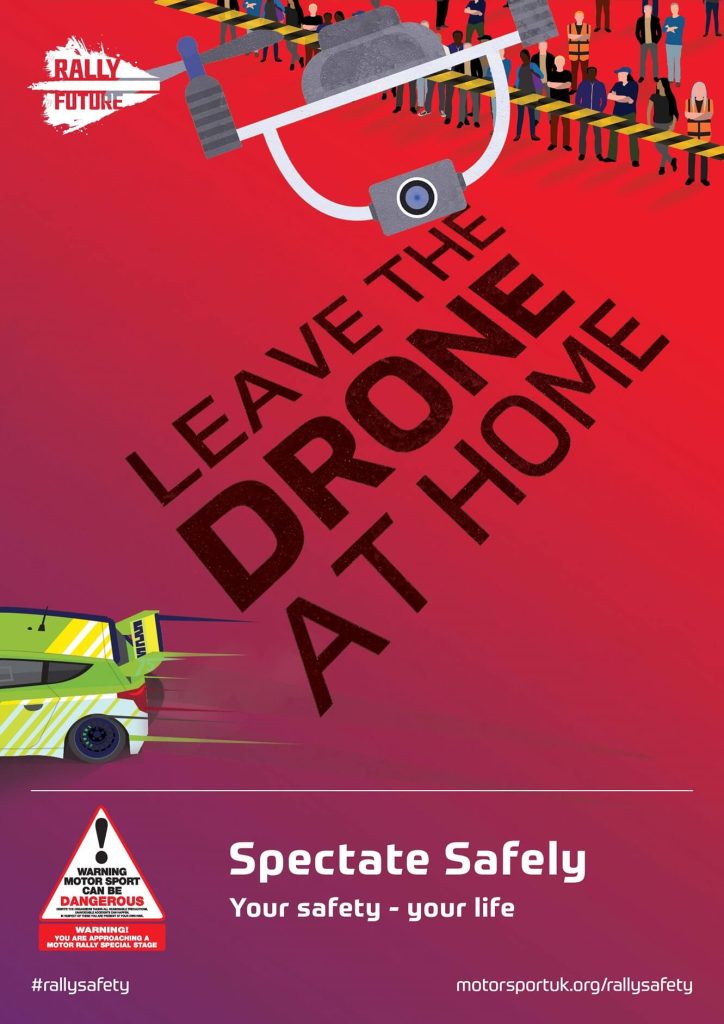
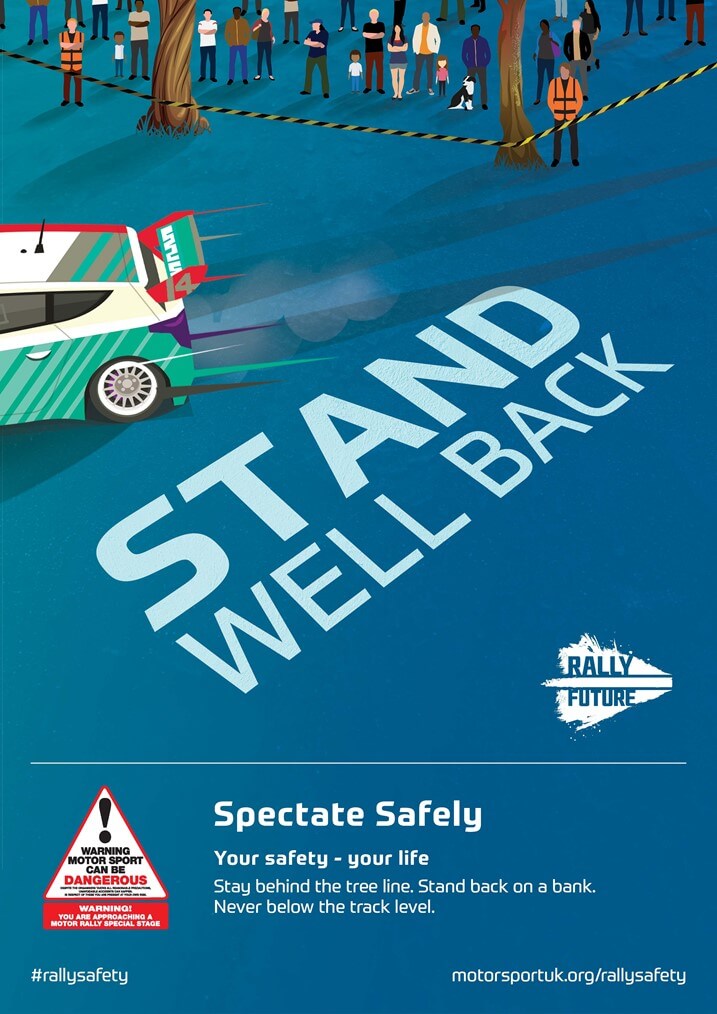
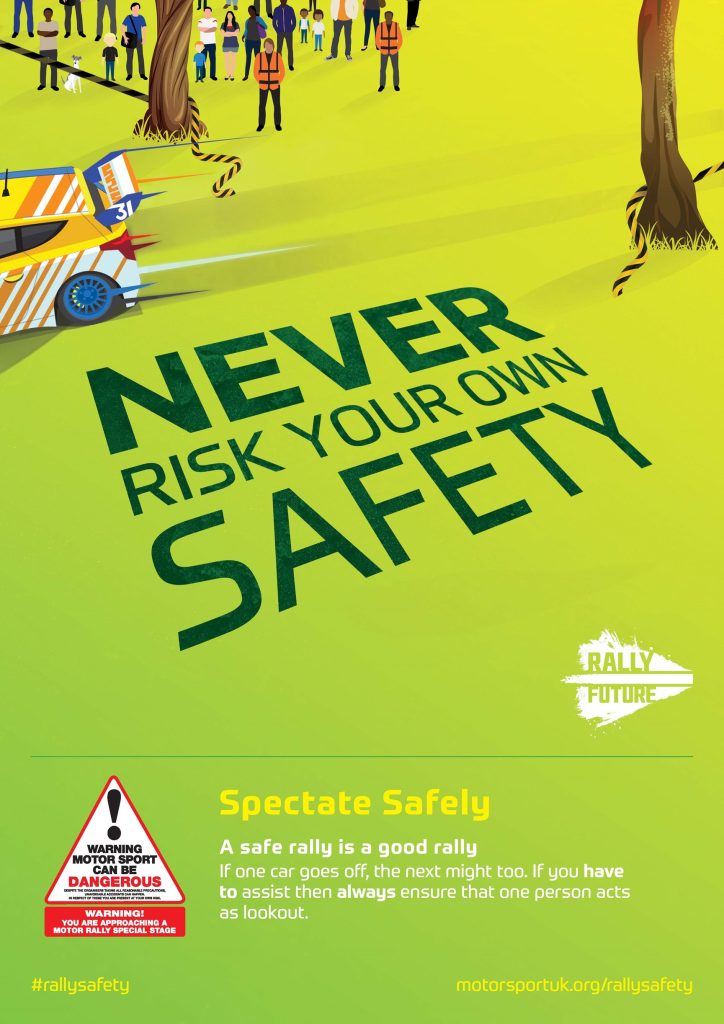
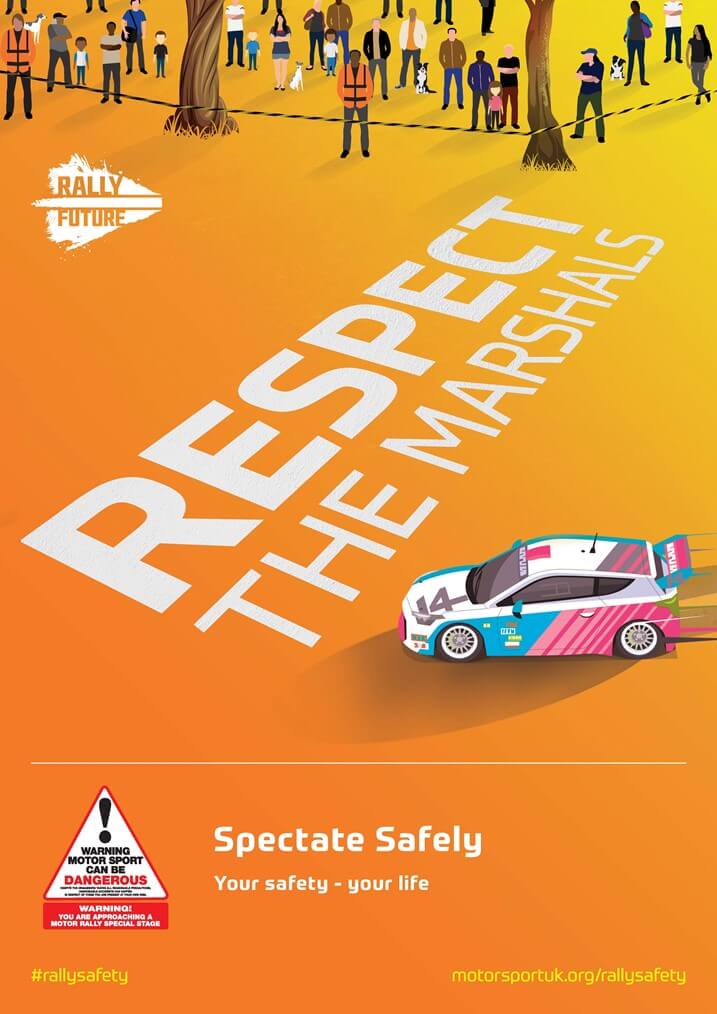
Please plan your event with safety in mind. The following points may help:
- We have tried to ensure that you will be able to reach your chosen spectator viewing area without walking on the special stage. If you decide to leave the stage prior to the last competitor, PLEASE ensure that you walk behind taped spectator areas and not on competitive stages. All the competitors will be travelling at high speeds and spectators are strongly advised NOT to walk on the rally route.
- All spectators are reminded that motorsport can be dangerous and despite us taking all reasonable precautions, unavoidable accidents can happen. In respect of these, you are present at your own risk.
- We ask that you obey all instructions of safety marshals, spectator marshals, council/security officers and police officers in relation to your safety and that of others.
- Marshals will warn of approaching cars by use of a whistle, please take this as a final signal to ensure you are standing in a safe place and concentrating on the action.
- Please make sure you dress suitably for the prevailing weather conditions and stout footwear is strongly recommended.
- Children and infants should ALWAYS be accompanied by an adequate amount of adults at all times who are responsible for their behaviour and safety.
- Beware of flying stones and uneven or slippery surfaces.
- Stay above the track (never below).
- Do not stand in the straight-on position – you will be told to move.
- Respect the signs and the tape; Yellow and Black is GOOD – i.e. it is ok to stand behind this tape. Red and White is bad, this is a NO GO area. Prohibited area MEANS prohibited area.
- Please be considerate to other spectators to ensure everyone can enjoy the event.
- Listen to the marshals – they are there to help you and ensure the event runs within the safety guidelines prescribed by Motorsport UK, the governing body of UK Motor Sport.
- If you do not abide by the instructions of marshals and event officials, the stage may be stopped or cancelled.
- Marshals and officials have the right to work without being abused or threatened.
- Consider your own safety and that of others at all time.
- Please take all litter home with you.
